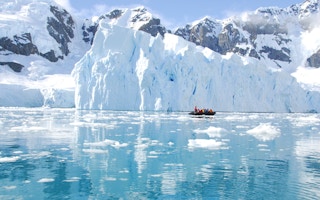Antarctica has been losing its ice cover at an average rate of 92 billion tonnes a year since at least 2003, according to new research.
And while the scientists can’t yet say for certain that human-made climate change is the main cause, they warn that the ice loss has the potential to have serious impacts on sea level rise.
The southern continent is the Earth’s largest store of fresh water, but is also its least studied area, having had no known human visitors until the late 18th century. So while scientists have a clear idea of processes at work in the Arctic, the big picture at the other end of the planet has been uncertain.
Heavier snowfalls
West Antarctica has been losing vast chunks of ice, but greater average warmth has meant there have been heavier snowfalls, and the icepack in east Antarctica has been on the increase.
Now Christopher Harig and Frederik Simons, geoscientists at Princeton University in the US, report in the journal Earth and Planetary Science Letters that gravitational satellite data has delivered a method of “weighing” the ice sheet, and identifying a pattern of change.
“
It has come to the point that if we continue losing mass in those areas, the loss can generate a self-reinforcing feedback, whereby we will be losing more and more ice, ultimately raising sea levels.
Christopher Harig, geoscientist at Princeton University
Most of the loss has been from the West Antarctic region, where the glaciers are increasingly unstable. In 2008, the region was shedding ice at the rate of 121 billion tons a year. By 2014, this rate of loss had doubled.
At the same time, the ice sheet in East Antarctica had thickened – but the gain made up for only about half the ice lost from the west.
In the period since 2003, ice loss over the whole continent increased at the rate of six billion tons a year. West Antarctica’s melting rate, however, accelerated by 18 billion tons a year during the same timespan.
So the researchers did the sums and arrived at an annual average loss of 92 billion tons a year. This could be envisaged as an iceberg the size of Manhattan Island in New York, and more than 1,600 metres high.
What the researchers cannot be sure of is the cause: is a natural cycle of climate at play, or is it a consequence of global warming because of greenhouse gas emissions from the burning of fossil fuels?
“We have a solution that is very solid, very detailed and unambiguous,” Dr Simons says. “A decade of gravity analysis alone cannot force you to take a position on this ice loss being due to anthropogenic global warming. All we have done is take the balance of the ice on Antarctica and found that it is melting – there is no doubt.
Rapidly accelerating
“But with the rapidly accelerating rates at which the ice is melting, and in the light of other, well-publicised lines of evidence, most scientists would be hard-pressed to find mechanisms that do not include human-made climate change.”
The two scientists used data from a US-German research satellite called GRACE − short for Gravity Recovery and Climate Experiment.
The agency linked to the ice loss is a measured warming of the southern ocean that is reducing the sea ice, which in turn holds back the flow of ice on land. So glaciers are melting, and flowing towards the sea at a faster rate.
“The fact that West Antarctic ice melt is still accelerating is a big deal because it’s increasing its contribution to sea level rise,” Dr Harig says. “It really has the potential to be a runaway problem.
“It has come to the point that if we continue losing mass in those areas, the loss can generate a self-reinforcing feedback, whereby we will be losing more and more ice, ultimately raising sea levels.”

















